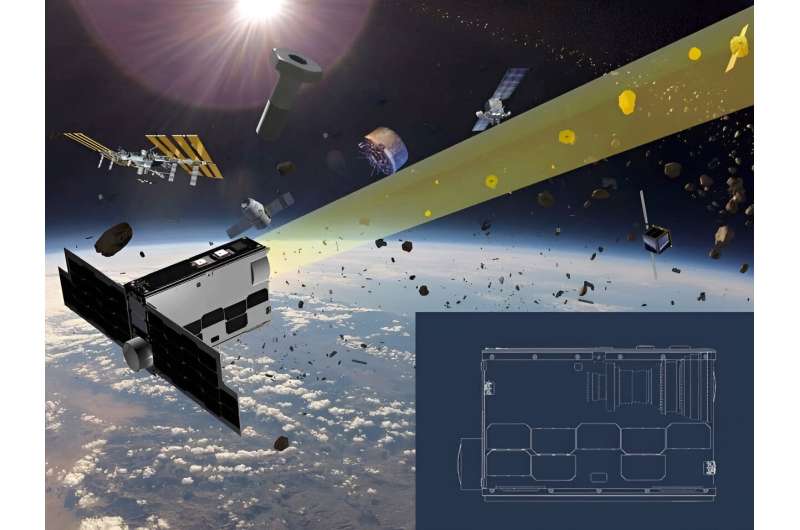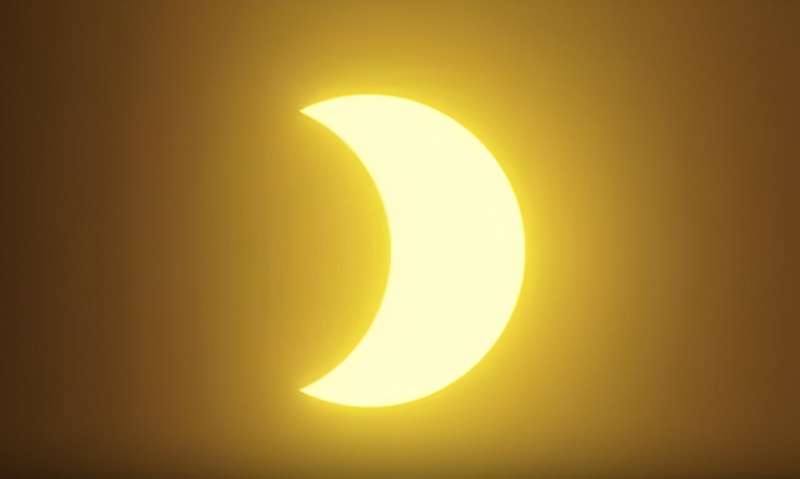Blue Canyon to supply spacecraft buses for NASA's PolSIR mission
Thursday, 13 June 2024 06:37 RTX's (NYSE: RTX) small satellite manufacturer and mission services provider, Blue Canyon Technologies, has been chosen to construct two 12U CubeSat buses for NASA's PolSIR mission. This mission aims to study ice clouds that form at high altitudes in tropical and sub-tropical regions.
Blue Canyon will design and manufacture the bus platforms and provide mission operations services.
T
RTX's (NYSE: RTX) small satellite manufacturer and mission services provider, Blue Canyon Technologies, has been chosen to construct two 12U CubeSat buses for NASA's PolSIR mission. This mission aims to study ice clouds that form at high altitudes in tropical and sub-tropical regions.
Blue Canyon will design and manufacture the bus platforms and provide mission operations services.
T Skyband chooses Hughes JUPITER for digital transformation of Saudi Arabia
Thursday, 13 June 2024 06:37 Hughes Network Systems, LLC (HUGHES), an EchoStar company (Nasdaq: SATS), announced that Luna Space Telecommunications Co. Ltd., a leading Saudi Arabia service provider under the Skyband Holding company, has purchased a JUPITER System Gateway and 1,200 Hughes JUPITER Terminals to transform its VSAT network. With the latest JUPITER technology, Skyband can provide higher speeds and throughput, rea
Hughes Network Systems, LLC (HUGHES), an EchoStar company (Nasdaq: SATS), announced that Luna Space Telecommunications Co. Ltd., a leading Saudi Arabia service provider under the Skyband Holding company, has purchased a JUPITER System Gateway and 1,200 Hughes JUPITER Terminals to transform its VSAT network. With the latest JUPITER technology, Skyband can provide higher speeds and throughput, rea Satellite megaconstellations could impact ozone hole recovery
Thursday, 13 June 2024 06:37 When old satellites fall into Earth's atmosphere and burn up, they leave behind tiny particles of aluminum oxide, which eat away at Earth's protective ozone layer. A new study finds these oxides have increased 8-fold between 2016 and 2022 and will continue to accumulate as the number of low-Earth-orbit satellites increases.
The 1987 Montreal Protocol successfully regulated ozone-damaging C
When old satellites fall into Earth's atmosphere and burn up, they leave behind tiny particles of aluminum oxide, which eat away at Earth's protective ozone layer. A new study finds these oxides have increased 8-fold between 2016 and 2022 and will continue to accumulate as the number of low-Earth-orbit satellites increases.
The 1987 Montreal Protocol successfully regulated ozone-damaging C FAA seeks public input on SpaceX Starship's environmental impact in Florida
Thursday, 13 June 2024 06:37 Officials with the Federal Aviation Administration are preparing an environmental impact statement regarding licensing for the SpaceX Starship and its super-heavy launch vehicle and want public input.
SpaceX wants a commercial launch vehicle operator license to use Launch Complex 39A at Kennedy Space Center in Florida, the FAA says.
SpaceX also wants to build launch and landing s
Officials with the Federal Aviation Administration are preparing an environmental impact statement regarding licensing for the SpaceX Starship and its super-heavy launch vehicle and want public input.
SpaceX wants a commercial launch vehicle operator license to use Launch Complex 39A at Kennedy Space Center in Florida, the FAA says.
SpaceX also wants to build launch and landing s Ariane 6 to launch RAMI Deployer for interplanetary missions
Thursday, 13 June 2024 06:37 Europe's newest rocket, Ariane 6, is set to launch soon, carrying multiple space missions. This flight will demonstrate the rocket's ability to launch various payloads, including new satellites for Earth observation, deep space exploration, and technology testing.
UARX Space's advanced mission injector, RAMI, will be part of the launch. This payload, about the size of a small suitcase, is
Europe's newest rocket, Ariane 6, is set to launch soon, carrying multiple space missions. This flight will demonstrate the rocket's ability to launch various payloads, including new satellites for Earth observation, deep space exploration, and technology testing.
UARX Space's advanced mission injector, RAMI, will be part of the launch. This payload, about the size of a small suitcase, is Laser tests reveal new insights into key mineral for super-Earths
Thursday, 13 June 2024 06:37 Scientists have for the first time observed how atoms in magnesium oxide morph and melt under ultra-harsh conditions, providing new insights into this key mineral within Earth's mantle that is known to influence planet formation.
High-energy laser experiments-which subjected tiny crystals of the mineral to the type of heat and pressure found deep inside a rocky planet's mantle-suggest the
Scientists have for the first time observed how atoms in magnesium oxide morph and melt under ultra-harsh conditions, providing new insights into this key mineral within Earth's mantle that is known to influence planet formation.
High-energy laser experiments-which subjected tiny crystals of the mineral to the type of heat and pressure found deep inside a rocky planet's mantle-suggest the Apex secures $95M in Series B Funding to Scale Satellite Bus Production
Thursday, 13 June 2024 06:37 Apex, a Los Angeles-based spacecraft manufacturing company, announced its $95 million Series B funding round. The round was led by XYZ Venture Capital and co-led by CRV, with participation from new investors Upfront, 8VC, Toyota Ventures, Point72 Ventures, Mirae Asset Capital, Outsiders Fund, GSBackers, and existing investors Andreessen Horowitz, Shield Capital, J2 Ventures, Ravelin, Baiju Bhatt
Apex, a Los Angeles-based spacecraft manufacturing company, announced its $95 million Series B funding round. The round was led by XYZ Venture Capital and co-led by CRV, with participation from new investors Upfront, 8VC, Toyota Ventures, Point72 Ventures, Mirae Asset Capital, Outsiders Fund, GSBackers, and existing investors Andreessen Horowitz, Shield Capital, J2 Ventures, Ravelin, Baiju Bhatt Drone tests radar system for planetary landings
Thursday, 13 June 2024 06:37 A drone took flight over Finland to evaluate the use of automotive radar technology for space applications. This technology, used in cars for automated cruise control, was tested for its potential in planetary landings and orbital rendezvous.
ESA collaborated with the VTT Technical Research Centre of Finland to test 77 GHz 'frequency-modulated continuous-wave' (FMCW) radar systems. These s
A drone took flight over Finland to evaluate the use of automotive radar technology for space applications. This technology, used in cars for automated cruise control, was tested for its potential in planetary landings and orbital rendezvous.
ESA collaborated with the VTT Technical Research Centre of Finland to test 77 GHz 'frequency-modulated continuous-wave' (FMCW) radar systems. These s CADvizor to design an advanced harness for GEO-KOMPSAT-3
Thursday, 13 June 2024 06:37 CADvizor has been successfully adopted as the wiring harness design CAD tool for the Korea Aerospace Research Institute (KARI)'s Geostationary Earth Orbit Korea Multi-Purpose Satellite-3 (GEO-KOMPSAT-3) project, marking its first implementation by a Korean aerospace company.
Developed entirely by a Korean wiring harness manufacturer YURA CO., LTD, the CADvizor solution, an advanced tool fo
CADvizor has been successfully adopted as the wiring harness design CAD tool for the Korea Aerospace Research Institute (KARI)'s Geostationary Earth Orbit Korea Multi-Purpose Satellite-3 (GEO-KOMPSAT-3) project, marking its first implementation by a Korean aerospace company.
Developed entirely by a Korean wiring harness manufacturer YURA CO., LTD, the CADvizor solution, an advanced tool fo AI transforming satellite imaging industry ‘but it’s not magic’
Wednesday, 12 June 2024 20:22

Parabolic flight with exoskeleton: Researchers test fine motor skills in weightlessness
Wednesday, 12 June 2024 19:36
Fine motor tasks under space conditions are particularly challenging and must first be trained on Earth. Scientists from the German Research Center for Artificial Intelligence (DFKI) and the University of Duisburg-Essen (UDE) are investigating whether a robotic exoskeleton that can simulate weightlessness is suitable for astronautical training.
The team had the opportunity to participate in the 42nd DLR Parabolic Flight Campaign in Bordeaux, France, to compare the effects of simulated weightlessness with those of real weightlessness.
During space missions, astronauts are often faced with fine motor tasks, such as performing repairs or experiments, that are made more difficult by the weightlessness of space. Targeted training of these skills is particularly important, not only to increase the efficiency of the missions, but also to ensure the safety of the astronauts. Until now, such missions could only be practiced on Earth during parabolic flights or in spacesuits underwater.
Innovative space training with exoskeleton
Scientists at the DFKI Robotics Innovation Center Bremen and the Department of Medical Engineering Systems at the University of Duisburg-Essen (UDE) are working on an alternative and more cost-effective training method.
A mission to find 10 million near-Earth asteroids every year
Wednesday, 12 June 2024 19:32
So far, scientists have found around 34,000 near-Earth asteroids (NEAs) that could serve as humanity's stepping stone to the stars. These balls of rock and ice hold valuable resources as we expand throughout the solar system, making them valuable real estate in any future space economy. But the 34,000 we know of only make up a small percentage of the total number of asteroids in our vicinity—some estimates theorize that up to 1 billion asteroids larger than a modern car exist near Earth.
A project from the Trans Astronautics Corp (TransAstra), an asteroid-hunting start-up based in California, hopes to find the missing billion: the Sutter Ultra project. Before we get into what Sutter Ultra is, it's best to understand why we have such a hard time finding the hundreds of millions of small asteroids in our vicinity.
To put it bluntly, the problem is two-fold—brightness and speed.
Video: Eclipse-making double-satellite Proba-3
Wednesday, 12 June 2024 19:10
Proba-3 is ESA's—and the world's—first precision formation flying mission. A pair of satellites will fly together relative to the sun so that one casts a precisely-controlled shadow onto the other, to create a prolonged solar eclipse in orbit.
In the process, the mission will open up the sun's faint surrounding coronal atmosphere for sustained study. Normally, this corona is rendered invisible by the brilliant face of the sun, like a firefly next to a bonfire.
Due for launch together this autumn, the two Proba-3 satellites will fly 144-m apart for up to six hours at a time to create these eclipses. Beside its scientific interest, this experiment will be a perfect method to demonstrate the precise positioning of the two platforms. It will be enabled using a novel combination of guidance technologies. In this video, the Proba-3 team details the mission concept.
Provided by European Space Agency
Quirky circling behavior in mice informs research on humans in space
Wednesday, 12 June 2024 18:57This article has been reviewed according to Science X's editorial process and policies. Editors have highlighted the following attributes while ensuring the content's credibility:
fact-checked
peer-reviewed publication
trusted source
proofread


